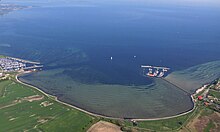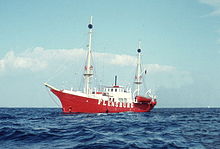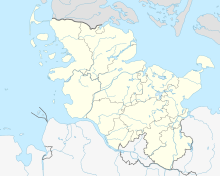Geltinger Bay
Coordinates: 54 ° 46 ′ 55 ″ N , 9 ° 51 ′ 21 ″ E


The Geltinger Bay is a bay of the Baltic Sea on the northeast coast of the fishing region at the exit of the Flensburg Fjord near Gelting . Thus, the Bay of Habernis extends in the northwest over the Wackerballig in the south to the Geltinger Birk nature reserve in the east . The coast length of the bay is around 15 kilometers. There is currently no commercial shipping route through the bay.
The coastal region belongs to the Amt of Geltinger Bucht with its administrative seat in Steinbergkirche. The region of the Geltinger Bucht is characterized on land by agriculture and tourism, on the water by sailing and some fishing.
Submarine self-sinking at the end of the war
In the night of May 4th to 5th, 1945 , a total of 47 submarines of the Kriegsmarine were self -sunk by their crews in the Geltinger Bucht, according to the rainbow order that had existed for a long time, but was canceled by Grand Admiral Dönitz on May 4th, 1945 so as not to have to hand them over to the victorious powers. This sinking took place twenty kilometers away from the special area Mürwik near Flensburg , where the last Reich President Karl Dönitz had retired, and immediately before the partial surrender to be carried out . Shortly after the subsequent unconditional surrender of the armed forces were on the speedboat escort ship Buea the three sailors, which was in Birk, Fritz Wehrmann , Alfred Gail and Martin Schilling for desertion sentenced to death and shot on 10 May 1945th The bodies of the three executed sailors were sunk in the Baltic Sea. A memorial stone today commemorates the three sailors on the beach in the bay.
Gelting pier
From August 1, 1965 to June 30, 1999 there was a shipping company for passenger and motor vehicle transport between Faaborg auf Fyn in Denmark and Germany with lines through the Gelting Bay to the pier at Gelting Mole. Since the ferry distance was 28 nautical miles and led outside the territorial waters of the time, the shipping company assumed a business model that, in addition to ferry operation and the management of fast-food restaurants and cafeterias, involved a considerable sale of goods at duty-free prices. These so-called butter trips contributed to a tourist boom around the Geltinger Bay. After the decision of the European Union (EU) to discontinue the duty-free sale of goods within the countries of the EU, not only the sale of goods on board the ferries decreased for the shipping company, but also the transfer of people in connection with the so-called butter trips. The shipping company of the Faaborg - Gelting Mole Line therefore ceased ferry operations through the Gelting Bay on June 30, 1999 due to a lack of profitability. Some of the technical facilities at the Gelting-Mole jetty were dismantled.
The Gelting pier is now used purely as a sports harbor.
Trailer
During the oil crisis from 1975 to 1979, up to 14 super tankers were anchored in the Geltinger Bay as trailers . These ships were shut down for a while due to lack of orders or low freight rates . Some tankers such as the Wilhelmine Essberger were launched at the Howaldtswerke-Deutsche Werft in Kiel in the Geltinger Bay immediately after being launched. The Geltinger Bay is particularly suitable as an anchorage for trailers due to its geographical location and the offshore shoal Kalkgrund (marked by a lighthouse ), as the bay also has sufficient water depth for ships 140 to 300 meters in length. Supply trips to the ships could easily be carried out from the nearby port of Gelting. The trailers during the oil crisis also developed as a tourist attraction, which brought additional income to the restaurants and hotels in the region.
Due to the shipping crisis in 2009, very specific plans for reactivating the bay as an anchorage for trailers were initially abandoned. However, the Kiel Ministry of the Environment only approved five berths for trailers, limited to three months and linked to strict environmental requirements.
See also
- Office of Geltinger Bucht
- Bernhard Asmussen: Geltinger Bucht - Projects and protests (The Fall of Man: The Nordstrasse / Ferry Port Gelting-Mole - Out and over / Oil tankers waiting - Tanker cemetery Geltinger Bucht / Concrete shipyard: Tankers for eternity / Olympic and sports boat port Gelting-Mole / Port village Niesholm - Living on the water) in: Yearbook of the Heimatverein der Landschaft fishing 2009
- Bernhard Asmussen: Kalkgrund - lightship and lighthouse in the Geltinger Bay, in: Yearbook of the Heimatverein der Landschaft fishing 2013
Web links
- Faaborg-Gelting Linien - a reminder website
Individual evidence
- ↑ Flensburger Tageblatt : Refusal of orders from above: U-boats and warships sink in the Baltic Sea , from: May 20, 2015; Retrieved on: June 29, 2017
- ↑ Hamburger Abendblatt : The night when 47 submarines sank , from: May 7, 2005; Retrieved on: June 29, 2017
- ↑ Flensburger Tageblatt: Faaborg-Gelting-Fähre: 35 years a gateway to Scandinavia, September 17, 2015 , accessed on October 8, 2015
- ↑ Sporthafen Gelting-Mole , accessed on: June 29, 2017
- ↑ Hamburger Abendblatt: Auflieger in Geltinger Bucht, March 25, 2009 , accessed on October 9, 2015
- ^ ZEIT-online: From the launch to the last voyage, June 27, 1975 , accessed on October 9, 2015
- ↑ SPIEGEL: Viereckige Augen, issue 18/1978 , accessed on October 8, 2015
- ^ Hamburger Abendblatt: The crisis is anchored in the Geltinger Bay, October 25, 2009 , accessed on October 9, 2015
- ↑ Verkehrsrundschau: Commercial lull: Ships anchor in Geltinger Bay, March 25, 2009 , accessed on October 9, 2015.
- ↑ Flensburger Tageblatt: No trailers in the Geltinger Bucht for the time being, November 17, 2009 , accessed on October 9, 2015

